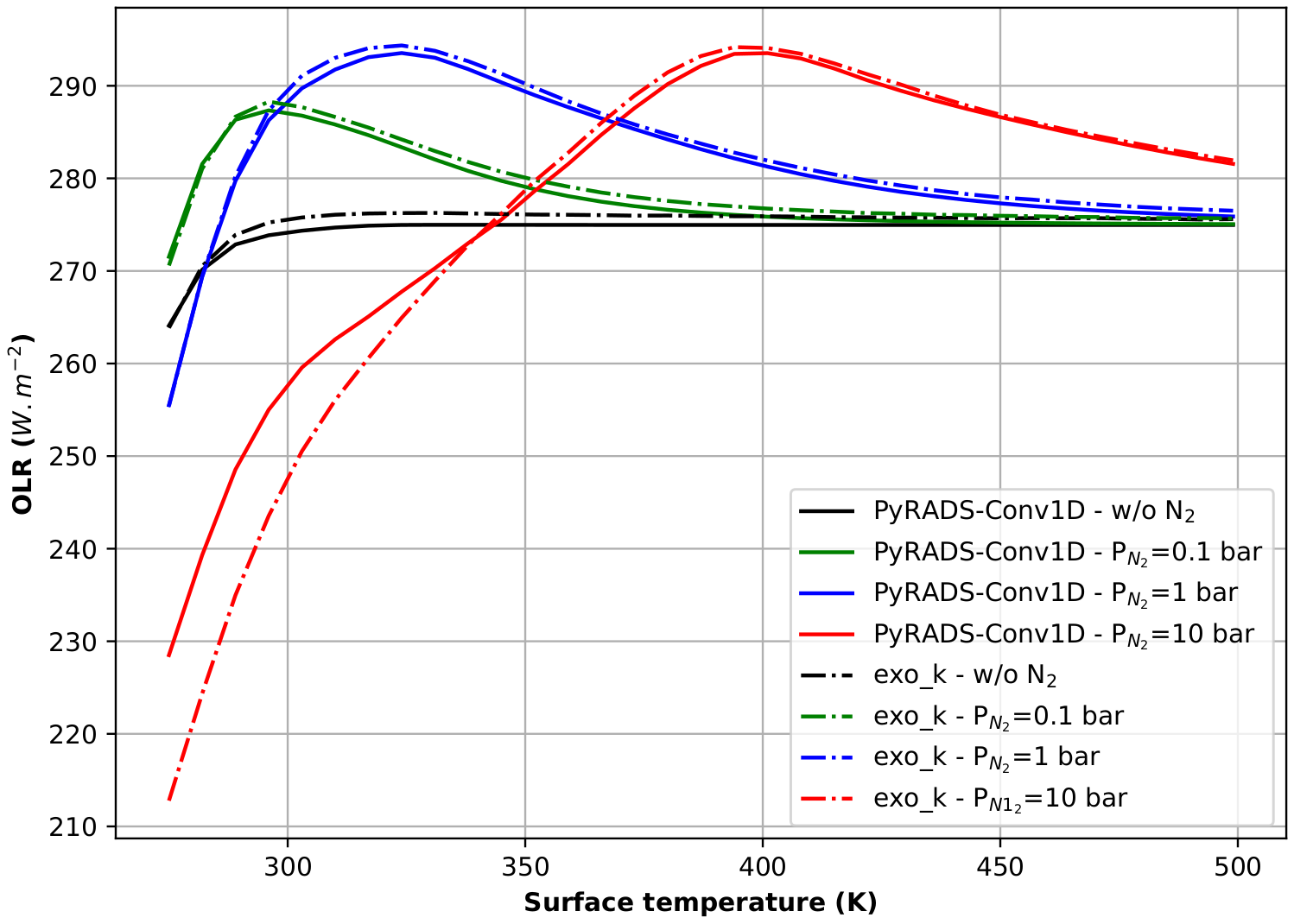How background gases can delay the onset of the runaway greenhouse? Insights from 1D and 3D modeling.
- University of Geneva, Observatory of Geneva, Versoix, Switzerland
1) Introduction
If an Earth-like planet with a large amount of water is drifted towards its host star, the surface temperature increases, which leads the atmosphere to enter a catastrophic runaway greenhouse state [1-4]. Studying this runaway greenhouse effect allows to better determine the runaway greenhouse insolation threshold and therefore the inner edge of the habitable zone (HZ).
Some studies [5-7] have shown that radiatively inactive background gases - such as N2 - can increase the Outgoing Longwave Radiation (OLR) and delay the onset of the runaway greenhouse. In other words, the OLR may “overshoot” the Simpson-Nakajima limit [4]. Consequently the inner edge of the HZ is moved closer to the star [8-11] and the planet is further from a catastrophic runaway greenhouse feedback. Explanations for this overshoot include the modification of the scale height of the atmosphere [7] or the coupled effect of the pressure broadening and a lapse rate close to a dry lapse rate [12]. However, there is still no consensus so far in the literature on whether an OLR overshoot is expected or not and what are the responsible mechanisms.
2) Method
First, we did multiple sensitivity tests to constrain the most important physical processes and parameterizations involved in 1D climate models by using a suite of models available in the literature [13-16]. This allows us to build a new hybrid 1D radiative-convective model named PyRADS-Conv1D to produce reference curves of the OLR relative to the surface temperature for H2O+N2 atmospheres (Fig. 1) to solve the question of the potential overshoot.
This sensitivity study, and particularly the understanding of the relevant processes involved in such atmospheres, are useful knowledge to produce accurate 3D simulations using a Global Climate Model (GCM). Therefore we are doing simulations with the LMD-Generic model for different theoretical study cases: a waterworld and a planet with Earth’s continents. Unique features of the LMD-Generic allow to explore the onset of the runaway greenhouse, even in situations where water is not a trace gas.
3) Results
By using the PyRADS-Conv1D model [17], we propose reference OLR curves relative to the surface temperature for different nitrogen pressures (Fig. 1). We confirm the occurrence of an overshoot of the OLR regarding the Simpson-Nakajima limit. We explain also that the non usual transition between a nitrogen dominated and a water dominated atmosphere challenges the modeling by making important usually second order processes. For example, neglecting the transition from the foreign to the self pressure broadening of the center of the water absorption lines leads to the suppression the overshoot [17]. PyRADS-Conv1D is based on the line-by-line radiative transfer method from PyRADS [7] but we built an accurate correlated-k table able to reproduce line-by-line results (exo_k curves on Fig. 1). This table is suitable for 3D GCM studies.
Finally we show through preliminary results from the LMD-Generic model (Fig. 2) that a GCM provides the same tendency than 1D models with a strong decrease of the OLR when the surface temperature increases, even without the radiative effect of the clouds. These results may be helpful to better understand the runaway greenhouse effect and thus the possible future of the Earth. We will explain in details during the presentation our results from 3D simulations for the different considered study cases assuming an H2O-dominated atmosphere.

Figure 1: OLR relative to the surface temperature for different nitrogen pressures. PyRADS-Conv1D is our reference 1D model. Exo_k [15] is an accurate 1D model used to test the correlated-k table built for this work.
Figure 2: OLR relative to the surface temperature with (blue curve) or without (green curve) the radiative effect of the clouds, using the 3D LMD-Generic model. Here we assume 1 bar of nitrogen.
References
[1] Komabayasi, M. 1967, Journal of the Meteorological Society of Japan. Ser. II
[2] Ingersoll, A. 1969
[3] Nakajima, S., Hayashi, Y.-Y., & Abe, Y. 1992, Journal of the Atmospheric Sciences
[4] Goldblatt, C. & Watson, A. J. 2012, Philosophical Transactions of the Royal Society A: Mathematical, Physical and Engineering Sciences
[5] Goldblatt, C., Claire, M. W., Lenton, T. M., et al. 2009, Nature Geoscience
[6] Goldblatt, C., Robinson, T. D., Zahnle, K. J. et al., 2013, Nature Geoscience
[7] Koll, D. D. B. & Cronin, T. W. 2019, The Astrophysical Journal
[8] Leconte, J., Forget, F., Charnay, B. et al., 2013, Nature
[9] Kopparapu, R. k., Ramirez, R., Kasting, J. F., et al. 2013, The Astrophysical Journal
[10] Ramirez, R. M. 2020, Monthly Notices of the Royal Astronomical Society
[11] Zhang, Y. & Yang, J. 2020, The Astrophysical Journal
[12] Pierrehumbert, R. T. 2010, Principles of planetary climate (Cambridge ; New York: Cambridge University Press)
[13] Koll, D. D. B. & Cronin, T. W. 2018, Proceedings of the National Academy of Sciences
[14] Turbet, M., Ehrenreich, D., Lovis, C. et al. 2019, Astronomy & Astrophysics
[15] Leconte, J. 2021, Astronomy & Astrophysics
[16] Marcq, E., Salvador, A., Massol, H. et al. 2017, Journal of Geophysical Research
[17] Chaverot et al. 2021, In prep.
How to cite: Chaverot, G., Bolmont, E., and Turbet, M.: How background gases can delay the onset of the runaway greenhouse? Insights from 1D and 3D modeling., European Planetary Science Congress 2021, online, 13–24 Sep 2021, EPSC2021-759, https://doi.org/10.5194/epsc2021-759, 2021.

